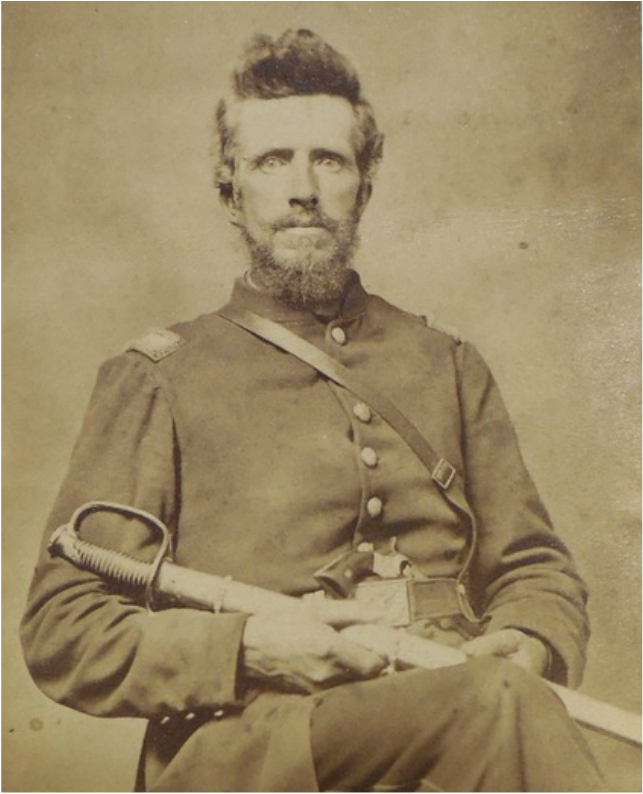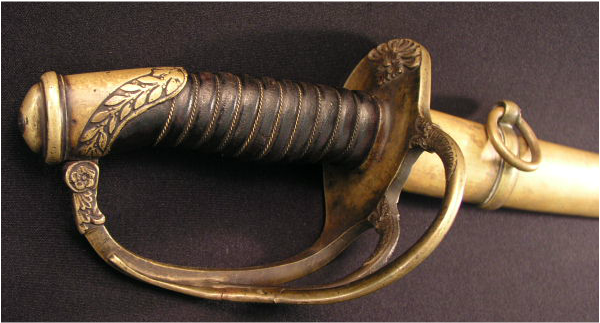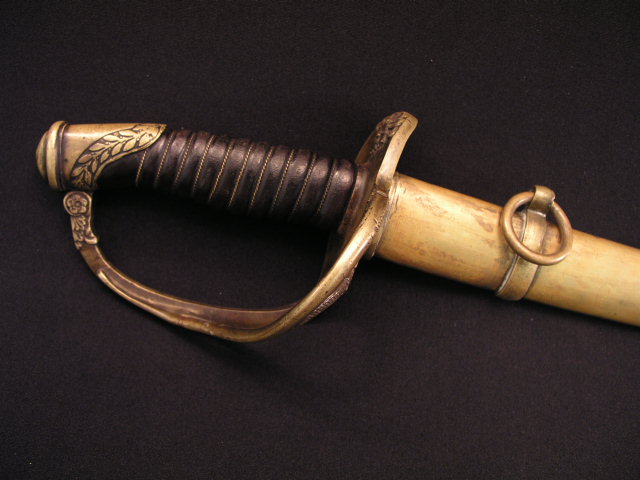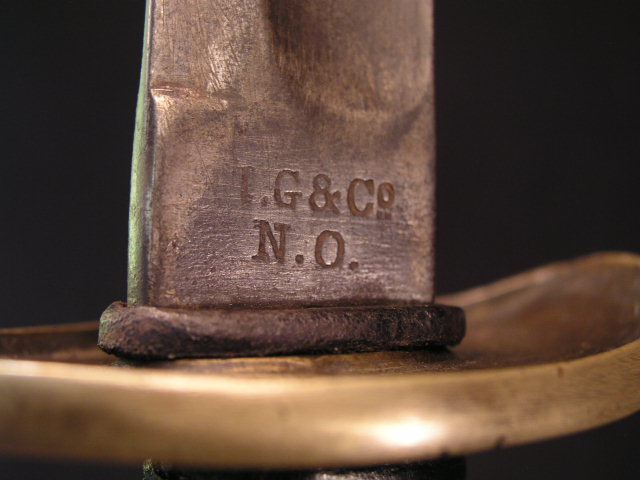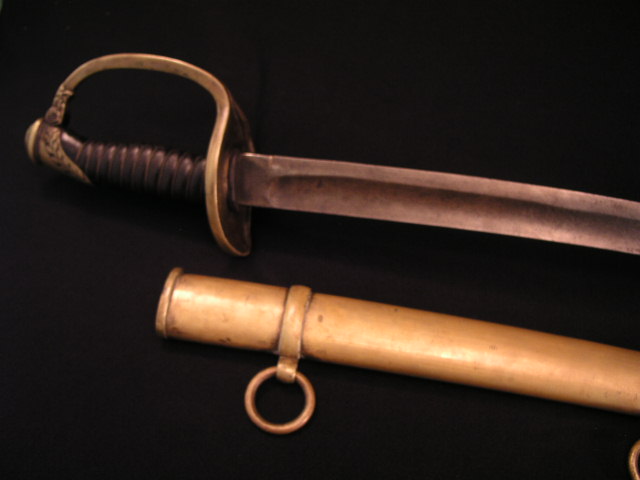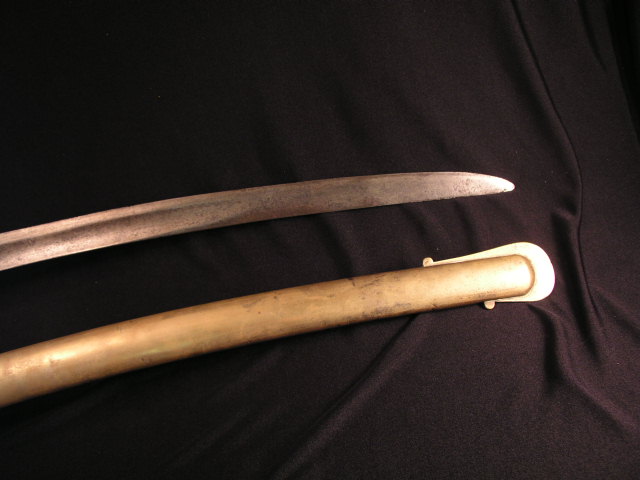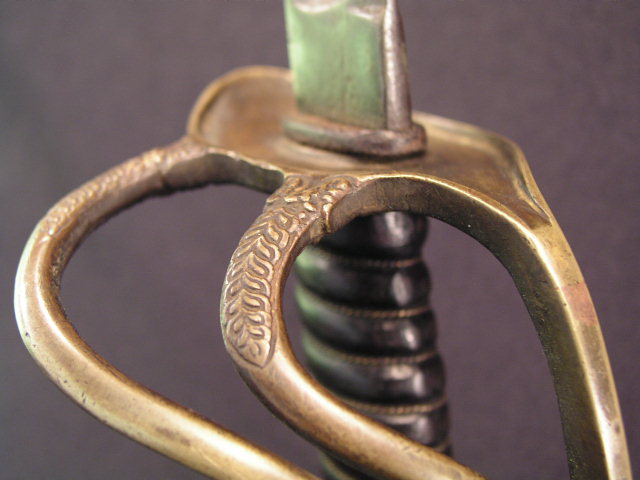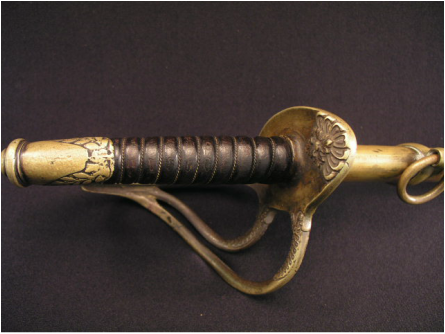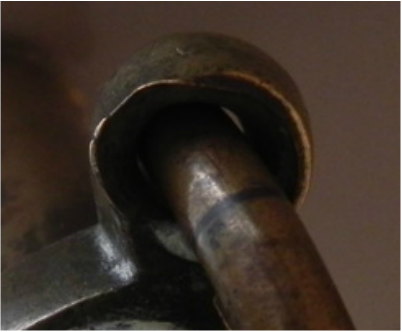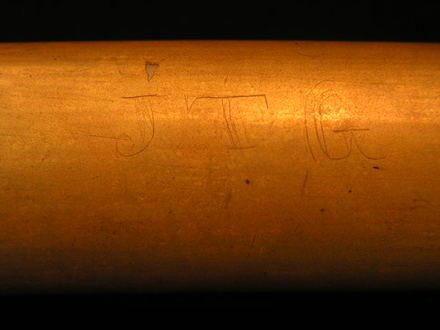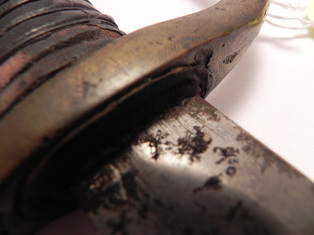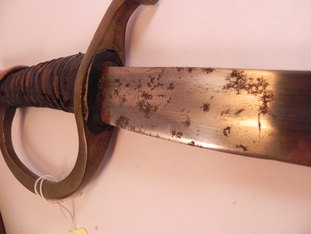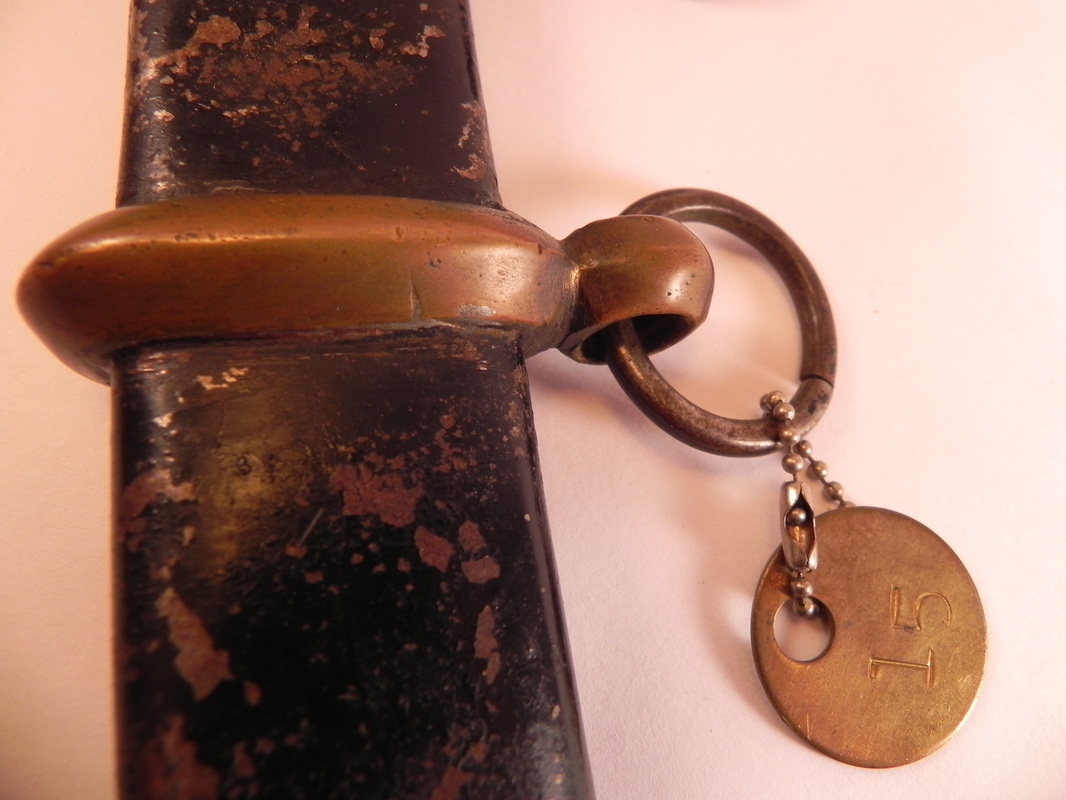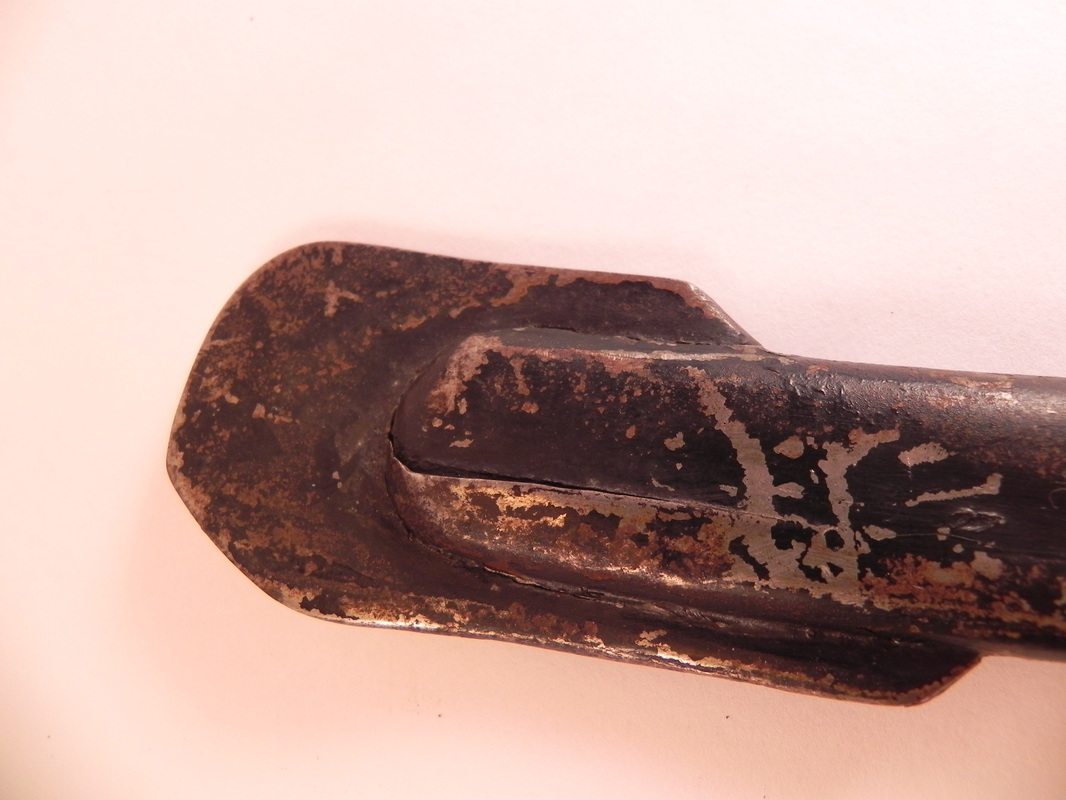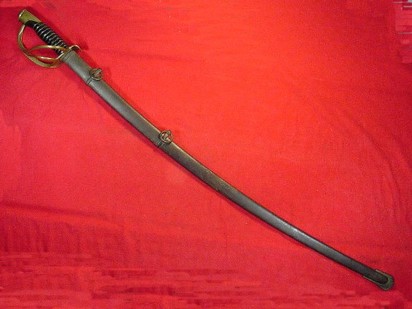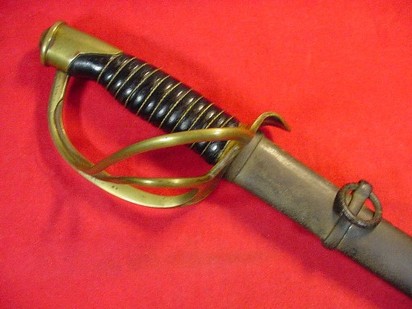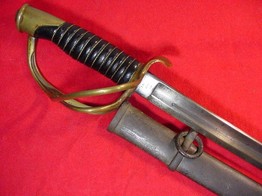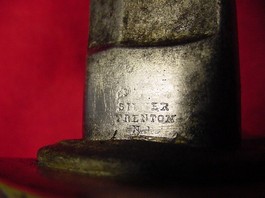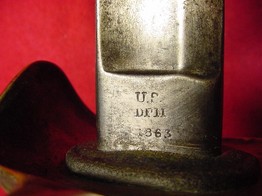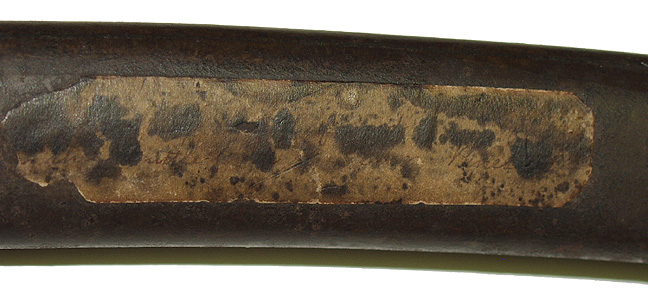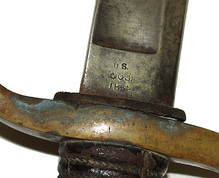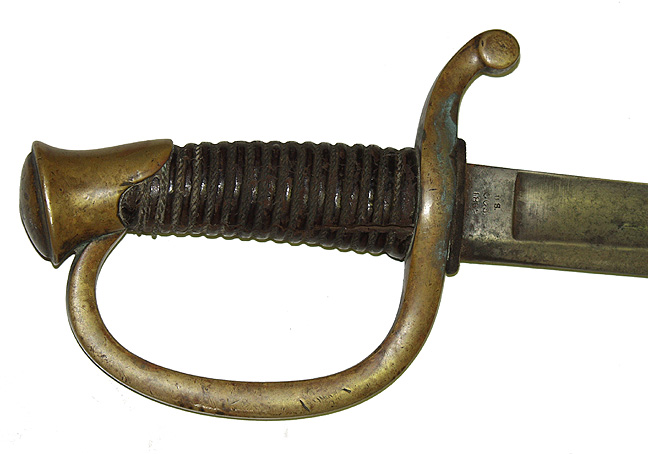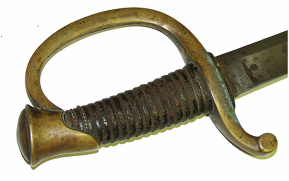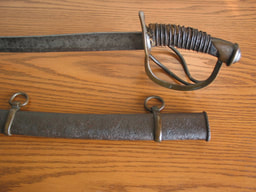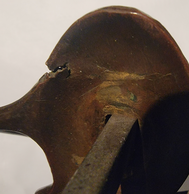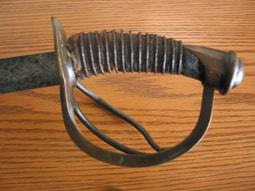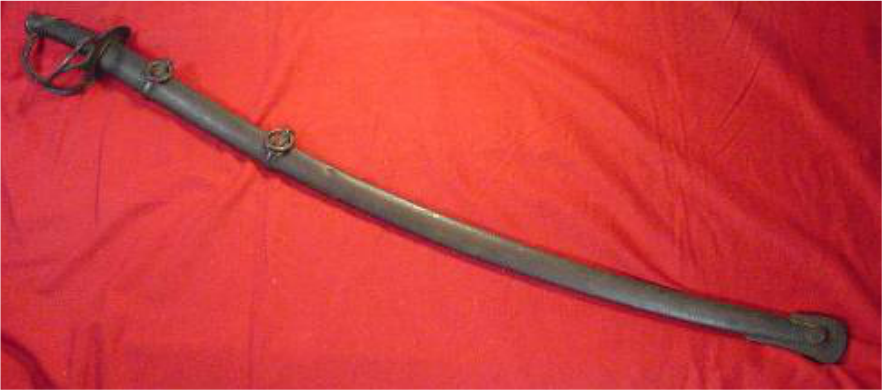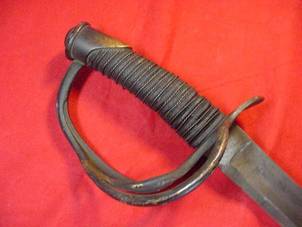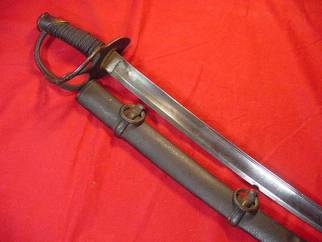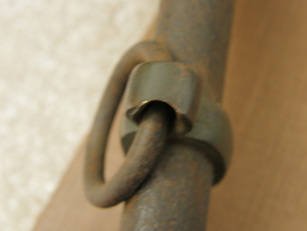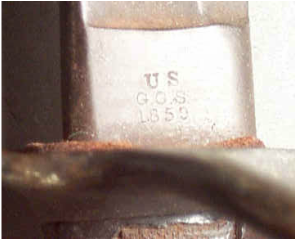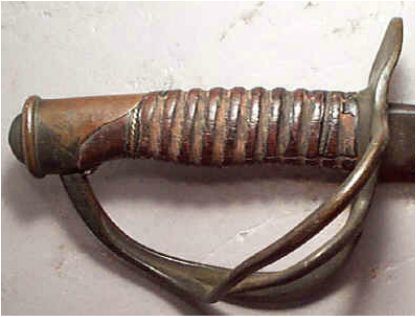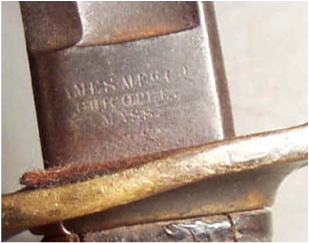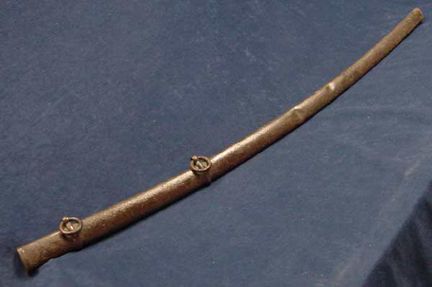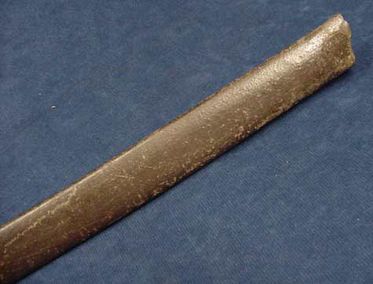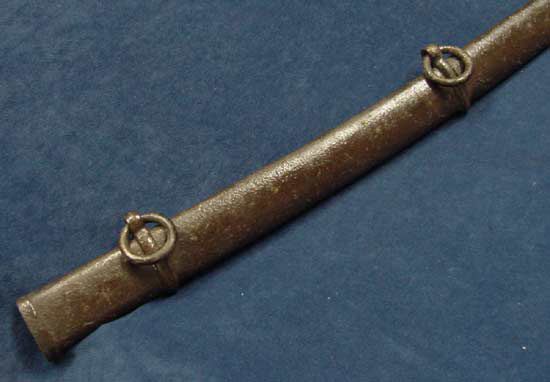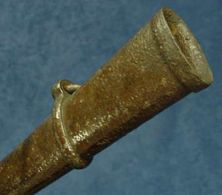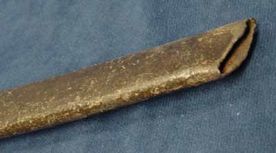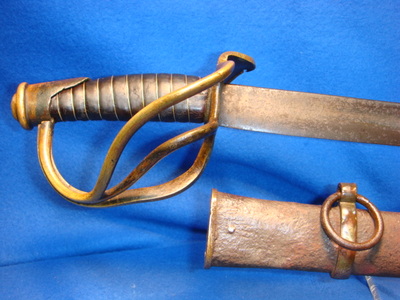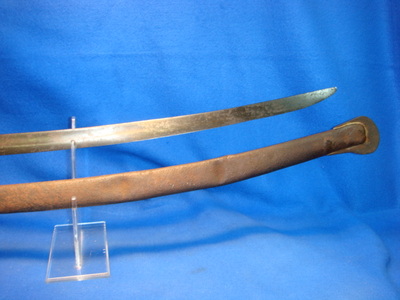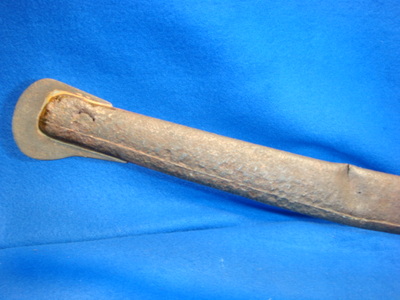Civil War Swords
THOMAS GRISWOLD OFFICER'S SABER
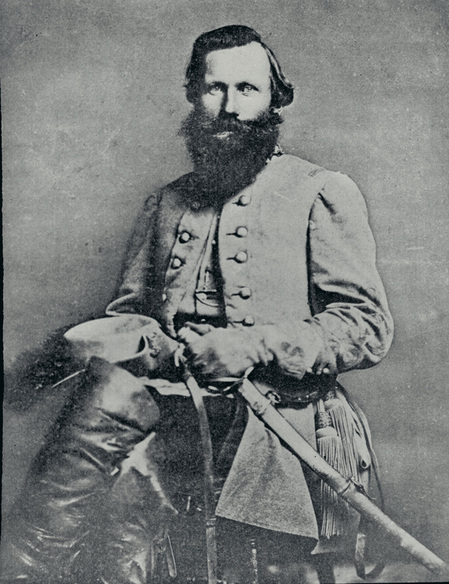
Henry Thomas and Arthur Breese Griswold of New Orleans were arguably the finest CS sword makers of the war. When the city was lost to the union in 1862 production of these unique, high quality swords ceased forever. This Thomas Griswold & Co. New Orleans marked Cavalry Officers Saber was in the collection of Jamie Deason of El Dorado, AK for 10 years prior to my purchase. It came out of a gun shop within 60 miles of Jackson Mississippi. Jamie was told that the sword was polished and cleaned from time to time and If you look closely you can see polishing residue in the voids and crevasses of the scabbard and saber hilt. The saber shows signs of being carried, but not abused. The top ring mount has the most wear, there are a few very light dings on the scabbard. I like the couple of small dings that were the result of being caught in the door when the officer carrying it did not move out of the doorway quick enough. The blade has the initialed Marking of "T.G. & Co over N.O". for Thomas Griswold and Company, New Orleans, It has a nice patina. At one time it was sharpened and has a fine edge. The matching patina would indicate the sharpening was period to its use. The hilt shows very little wear as does the grip wrap. The leather is in very nice condition with only a few spots worn through. This saber has the smaller twisted wire wrapped on the grip and is complete and original. The top of the pommel has a nice undisturbed patina on the iron peen and surrounding brass clearly indicating this saber has never been disassembled since it was originally produced. This is the cavalry officer version with the 35.25 inch blade. The blade is well made with a semi-stopped fuller. It has gray patina with a smooth attractive look on both sides. The guard and pommel cap are typical Confederate style manufacture. The officer guard branches, quillon and top of knuckle bow have cast floral patterns as well as pommel decoration. The guard has the crude splice of the two piece construction which is characteristic of a New Orleans product and the pommel cap also has the seam showing a two piece pommel cap which is also a New Orleans characteristic. Thomas Griswold is best known for their solid brass scabbards. There are initials carved in the scabbard. This sword was envied by officers both North and South during the Civil War. There are several known examples inscribed to Confederate Generals and one captured and carried by Union General Brigade Commander Marcellus Crocker.
(Reference; "Collecting The Confederacy" by Shannon Pritchard, page 247,;"The Illustrated History of American Civil War Relics" by Stephen W. Sylvia & J. O'Donnell, page 302; "Confederate Edged Weapons" by William A. Albaugh III, page 96;"Historic American Swords" by Howard R. Crouch, page 132; "Civil War Relics of the Western Campaigns" by Charles S. Harris, page 157; "Swords of the American Civil War" by Richard H. Bezdek , page 248; " Confederate Arms" by William A. Albaugh lll and Edward N. Simmons, page 105-108; "A Photographic Supplement of Confederate Swords" by William A. Albaugh III, pages 151-153).
Henry Thomas and Arthur Breese Griswold of New Orleans were arguably the finest CS sword makers of the war. When the city was lost to the union in 1862 production of these unique, high quality swords ceased forever. This Thomas Griswold & Co. New Orleans marked Cavalry Officers Saber was in the collection of Jamie Deason of El Dorado, AK for 10 years prior to my purchase. It came out of a gun shop within 60 miles of Jackson Mississippi. Jamie was told that the sword was polished and cleaned from time to time and If you look closely you can see polishing residue in the voids and crevasses of the scabbard and saber hilt. The saber shows signs of being carried, but not abused. The top ring mount has the most wear, there are a few very light dings on the scabbard. I like the couple of small dings that were the result of being caught in the door when the officer carrying it did not move out of the doorway quick enough. The blade has the initialed Marking of "T.G. & Co over N.O". for Thomas Griswold and Company, New Orleans, It has a nice patina. At one time it was sharpened and has a fine edge. The matching patina would indicate the sharpening was period to its use. The hilt shows very little wear as does the grip wrap. The leather is in very nice condition with only a few spots worn through. This saber has the smaller twisted wire wrapped on the grip and is complete and original. The top of the pommel has a nice undisturbed patina on the iron peen and surrounding brass clearly indicating this saber has never been disassembled since it was originally produced. This is the cavalry officer version with the 35.25 inch blade. The blade is well made with a semi-stopped fuller. It has gray patina with a smooth attractive look on both sides. The guard and pommel cap are typical Confederate style manufacture. The officer guard branches, quillon and top of knuckle bow have cast floral patterns as well as pommel decoration. The guard has the crude splice of the two piece construction which is characteristic of a New Orleans product and the pommel cap also has the seam showing a two piece pommel cap which is also a New Orleans characteristic. Thomas Griswold is best known for their solid brass scabbards. There are initials carved in the scabbard. This sword was envied by officers both North and South during the Civil War. There are several known examples inscribed to Confederate Generals and one captured and carried by Union General Brigade Commander Marcellus Crocker.
(Reference; "Collecting The Confederacy" by Shannon Pritchard, page 247,;"The Illustrated History of American Civil War Relics" by Stephen W. Sylvia & J. O'Donnell, page 302; "Confederate Edged Weapons" by William A. Albaugh III, page 96;"Historic American Swords" by Howard R. Crouch, page 132; "Civil War Relics of the Western Campaigns" by Charles S. Harris, page 157; "Swords of the American Civil War" by Richard H. Bezdek , page 248; " Confederate Arms" by William A. Albaugh lll and Edward N. Simmons, page 105-108; "A Photographic Supplement of Confederate Swords" by William A. Albaugh III, pages 151-153).
CS ARTILLERY SWORD
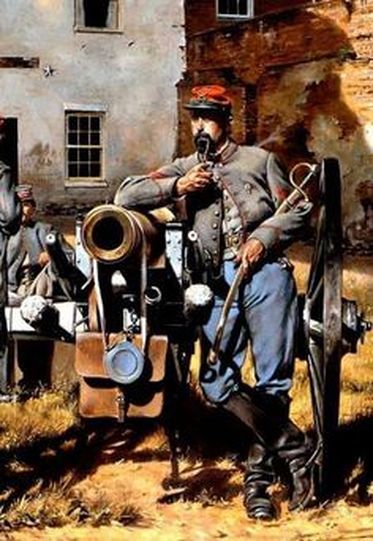
Confederate 'Dog River' Enlisted Artillery Saber With Black Japanned Scabbard. The 32" blade is excellent with unstopped fuller that runs open to the hilt and to within 8 1/2" of the tip. Bright and clean with no rust or pitting and just some minor small 'spider web' like stains scattered about. Retains the original leather washer. Classic hilt form emulating the US M1840 but with obviously cruder finish. Perfect with untouched patina. The pommel cap displays a noticeably higher copper content than the guard. The wood grip channeled to accept 13 turns of single strand iron wire. Retains about 60% of the original black oilcloth wrap with the reverse side of the grip missing just a few chips, most of the loss being visible on the obverse side. Sheet iron scabbard with prominent lap seam along the back edge retains 80% of what appears to be the original black Japanned finish. Heavy brass ring mounts with median ridges, iron rings and drag, which shows obvious honest wear. Absolutely no rust or pitting but two minor dents near the top of the scabbard on the obverse. There is a recess in the guard for the scabbard like the US Army Type 1 saber it copies. The saber retains an oriiginal washer that fits snuggly into the recess. I don't know the reason the washer was installed ( to stop the rattle? to make for a quicker "draw") but I have seen a few examples of this saber with the washer in the "recessed" CS sabers. The scabbard is fabricated without a throat which of course allows the proper fit to the saber. As fine an example of this rare form of "Dog River" saber one could hope to obtain. CS artillery sabers are rare. No known reason for this but the fact remains, according to William Albaugh, that three or four officer's swords show up for each artillery saber. There is some speculation as to the manufacturer of this saber but most contribute this model to Boyle & Gamble and given the classic "flaw" under the guard as well as the exceptionally heavy brass mounts on the scabbard I do believe this to be a Boyle and Gamble.This saber is from the Steve Hess Collection.
(Reference; "Historical American Swords" by Howard R. Crouch, page 153; "Confederate Edged Weapons" by William A. Albaugh III, page 133; "Swords of the American Civil War" by Richard H. Bezdeck, page 252; "Swords of the American Civil War" by Richard H. Bezdek , page 252; "A Photographic Supplement of Confederate Swords" by William A. Albaugh III, page 198)
U.S. EMERSON & SILVER LIGHT CAVALRY SABER
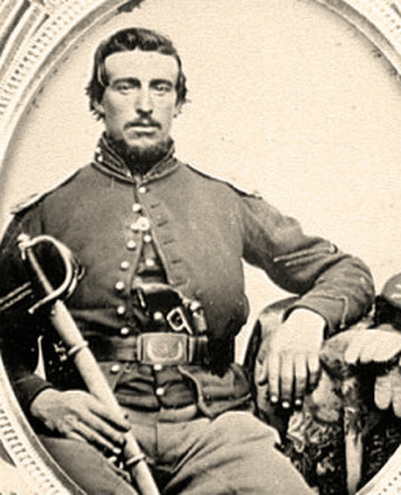
This is the model 1860 cavalry saber referred to by collectors as the light cavalry because of the lighter weight and more streamlined design compared to the earlier model 1840 cavalry saber. A very desirable "1863" date saber manufactured by the Emerson & Silver company of Trenton NJ. This is one of the New Jersey Contracts by state and not a Federal contract sword. The highlight of this saber is the fine leather grip and original wire wrap.The brass has an attractive light patina. The pommel is marked with inspector's initials "DFM" which matches the ricasso. This would be the initials for Dexter F, Mossman who inspected for the government from 1862 until 1864.. The blade has no nicks and is just starting to turn gray. The guard has a nice aged patina and is bent forward to provide thumb pressure indicating actual field use, The ricasso is stamped "US"/ DFM/ 1863" and a well worn "Emerson/ &/Silver/ Trenton/ NJ" and has the original leather washer. The steel scabbard has a smooth uncleaned brown patina with dings from service and a couple of anti-rattle punches. A nice mid-war dated saber.
(Reference: "Civil War Cavalry & Artillery Sabers" by John H.Thillmann page175; "Historic American Swords" by Howard R. Crouch, page 27; " Arms and Equipment of the Union" by Time-Life Books, page 78; 'Warman's Civil War Weapons" by Graham Smith, page 242)
(Reference: "Civil War Cavalry & Artillery Sabers" by John H.Thillmann page175; "Historic American Swords" by Howard R. Crouch, page 27; " Arms and Equipment of the Union" by Time-Life Books, page 78; 'Warman's Civil War Weapons" by Graham Smith, page 242)
M1840 AMES ARTILLERY SABER FROM SEVEN PINES BATTLEFIELD
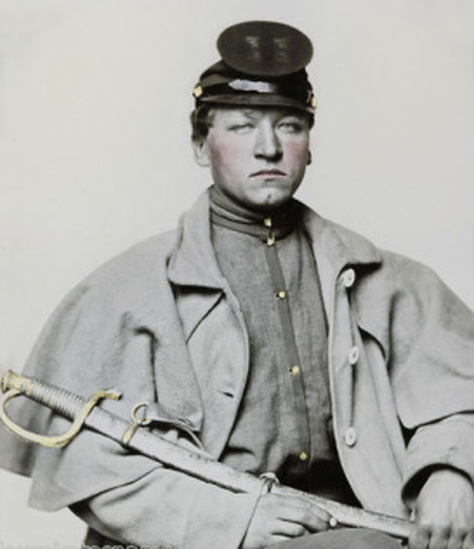
What makes this sword very special is the old handwritten tag attached to the scabbard between the mounts which reads "Artillery sword found after battle from Seven Pines, Va" (Also known as the Battle of Fair Oaks).
"This two day fight was part of the Peninsula Campaign. On May 31, 1862 Gen. Joseph E. Johnston attempted to overwhelm two Federal corps that appeared isolated south of the Chickahominy River. The Confederate assaults, though not well coordinated, succeeded in driving back the IV Corps and inflicting heavy casualties. Reinforcements arrived, and both sides fed more and more troops into the action. Supported by the III Corps and Sedgwick’s division of Sumner’s II Corps (that crossed the rain-swollen river on Grapevine Bridge), the Federal position was finally stabilized. Gen. Johnston was seriously wounded during the action, and command of the Confederate army devolved temporarily to Maj. Gen. G.W. Smith. On June 1, the Confederates renewed their assaults against the Federals who had brought up more reinforcements but made little headway. Both sides claimed victory. Confederate brigadier Robert H. Hatton was killed."
This pattern 1840 is called the second variation or referenced to as Type 2 and was made from 1860 to 1865. It has a flush guard on the blade side without a recess and its corresponding scabbard has a throat mount. The blade washer was flush with the guard and the pommel cap was a dome, making the blade tang more secure to the hilt. This sword was manufactured in 1862, one of 839 delivered that year. Ames marking is visible but light. The "US, G.G.S. 1862" markings are strong. The Blade has a gray patina, with very light areas of pitting. Scabbard has a dark olive patina. Nice patina to the brass hilt. The leather grip intact with 1 1/2" long split in wood and leather. Wire wrap is missing. A nice early battlefield relic in untouched condition.
(Reference: "Civil War Cavalry & Artillery Sabers" by John H.Thillmann page 97; "Historic American Swords" by Howard R. Crouch, page 45; "Swords of the American Civil War" by Richard H. Bezdek , page 163; 'Warman's Civil War Weapons" by Graham Smith, page 250)
"This two day fight was part of the Peninsula Campaign. On May 31, 1862 Gen. Joseph E. Johnston attempted to overwhelm two Federal corps that appeared isolated south of the Chickahominy River. The Confederate assaults, though not well coordinated, succeeded in driving back the IV Corps and inflicting heavy casualties. Reinforcements arrived, and both sides fed more and more troops into the action. Supported by the III Corps and Sedgwick’s division of Sumner’s II Corps (that crossed the rain-swollen river on Grapevine Bridge), the Federal position was finally stabilized. Gen. Johnston was seriously wounded during the action, and command of the Confederate army devolved temporarily to Maj. Gen. G.W. Smith. On June 1, the Confederates renewed their assaults against the Federals who had brought up more reinforcements but made little headway. Both sides claimed victory. Confederate brigadier Robert H. Hatton was killed."
This pattern 1840 is called the second variation or referenced to as Type 2 and was made from 1860 to 1865. It has a flush guard on the blade side without a recess and its corresponding scabbard has a throat mount. The blade washer was flush with the guard and the pommel cap was a dome, making the blade tang more secure to the hilt. This sword was manufactured in 1862, one of 839 delivered that year. Ames marking is visible but light. The "US, G.G.S. 1862" markings are strong. The Blade has a gray patina, with very light areas of pitting. Scabbard has a dark olive patina. Nice patina to the brass hilt. The leather grip intact with 1 1/2" long split in wood and leather. Wire wrap is missing. A nice early battlefield relic in untouched condition.
(Reference: "Civil War Cavalry & Artillery Sabers" by John H.Thillmann page 97; "Historic American Swords" by Howard R. Crouch, page 45; "Swords of the American Civil War" by Richard H. Bezdek , page 163; 'Warman's Civil War Weapons" by Graham Smith, page 250)
CONFEDERATE SWORD

This is a Confederate Haiman Cavalry Saber made by L. Haiman & Brother, Columbus, Georgia. Louis Haiman, and his brother Elijah, operated in Columbus Georgia throughout the entire Civil War, and their sabers are easily identifiable by the distinct shape of the hilt, and the material and heavy wire used on the grip, though there are a few variants such as a different scabbard or wire. Most of the sabers have a lapped-seam scabbard, but this example is a higher quality scabbard that is well made with a brazed seam, brass mounts, and brass rings. It is believed these scabbards were made by McElroy and supplied to Haiman to fill a contract for Officer sabers. This saber retains some of its original leather and all the single iron wire wrap on the grip. The McElroy made scabbard has brass mounts and brass rings, and a steel throat and a brazed seam..
I purchased this blade from Lawrence Christopher of Dalton, Ga. It was recovered in 2004 out of North Georgia. The blade has the classic unstopped fuller a dark grey patina and is stained and pitted from poor storage. The tip of the blade appears to have been reground at some point. The "peen" is untouched. The wear on the wrap is heaviest were the pressure from the hand would have been the greatest. Further graphic evidence of heavy use. It has the Haiman traits including the distinctive curved grip which slims at the handle end and retains its heavy wire wrap and remnants of the painted oil cloth wrap. This grip bend is more pronounced due to the wood core on the underside being worn through to the tang. The guard has the distinctive Confederate casting flaws. The scabbard has the iron throat and drag peculiar to Haiman and the wide brass rings. This weapon has lots of service dents from heavy use. The scabbard is the classic Confederate construction made of a single sheet of iron folded over and brazed rather than having the lapsed seam - both finishing being distinctly Confederate. The ring mounts, of course are brass. As with all Haiman scabbards the drag is iron. The brass guard color is distinctly "Confederate" and can best be shown by holding the brass of a truly Confederate sword up to the brass of a U.S, sword. The high copper/low zinc content in the brass is a very distinctive red hue. The obvious difference in coloring on the underside of the guard relative to the rest of the brass shows clearly the sword was stored in the scabbard many, many years - the patina aged and changed everywhere on the handle except the part that was protected where the scabbard throat rested against the bottom of the handle. This was "rode hard and put away wet" and I like the rebel feel that all the "new to the market, barely used" specimens you see today don't have. This one "saw the elephant, has an interesting nick in the guard, and was somehow brought back to Georgia by a returning rebel who stood it up in a corner somewhere not thinking of the historic significance.
(Reference; "Confederate Edged Weapons" by William A. Albaugh III, page 115; "Historical American Swords" by howard R. Crouch, page113; "Swords of the American Civil War" by Richard H. Bezdeck, page 241; " Confederate Arms" by William A. Albaugh lll and Edward N. Simmons, page 115-116; "A Photographic Supplement of Confederate Swords" by William A. Albaugh III, page 192)
I purchased this blade from Lawrence Christopher of Dalton, Ga. It was recovered in 2004 out of North Georgia. The blade has the classic unstopped fuller a dark grey patina and is stained and pitted from poor storage. The tip of the blade appears to have been reground at some point. The "peen" is untouched. The wear on the wrap is heaviest were the pressure from the hand would have been the greatest. Further graphic evidence of heavy use. It has the Haiman traits including the distinctive curved grip which slims at the handle end and retains its heavy wire wrap and remnants of the painted oil cloth wrap. This grip bend is more pronounced due to the wood core on the underside being worn through to the tang. The guard has the distinctive Confederate casting flaws. The scabbard has the iron throat and drag peculiar to Haiman and the wide brass rings. This weapon has lots of service dents from heavy use. The scabbard is the classic Confederate construction made of a single sheet of iron folded over and brazed rather than having the lapsed seam - both finishing being distinctly Confederate. The ring mounts, of course are brass. As with all Haiman scabbards the drag is iron. The brass guard color is distinctly "Confederate" and can best be shown by holding the brass of a truly Confederate sword up to the brass of a U.S, sword. The high copper/low zinc content in the brass is a very distinctive red hue. The obvious difference in coloring on the underside of the guard relative to the rest of the brass shows clearly the sword was stored in the scabbard many, many years - the patina aged and changed everywhere on the handle except the part that was protected where the scabbard throat rested against the bottom of the handle. This was "rode hard and put away wet" and I like the rebel feel that all the "new to the market, barely used" specimens you see today don't have. This one "saw the elephant, has an interesting nick in the guard, and was somehow brought back to Georgia by a returning rebel who stood it up in a corner somewhere not thinking of the historic significance.
(Reference; "Confederate Edged Weapons" by William A. Albaugh III, page 115; "Historical American Swords" by howard R. Crouch, page113; "Swords of the American Civil War" by Richard H. Bezdeck, page 241; " Confederate Arms" by William A. Albaugh lll and Edward N. Simmons, page 115-116; "A Photographic Supplement of Confederate Swords" by William A. Albaugh III, page 192)
U.S. MODEL 1840 "OLD WRISTBREAKER" HEAVY CAVALRY SABER
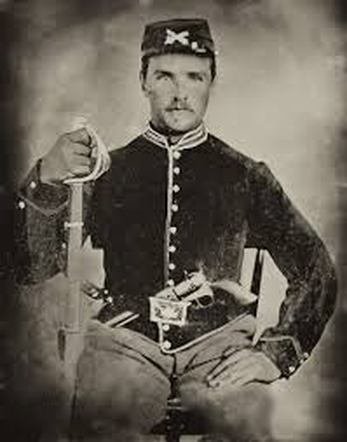
The model 1840 saber, called the "wrist breaker", was a heavy cavalry saber, and was manufactured before the Civil War. Standard features include a relatively straight wooden handle covered with leather and a wire grip. The brass hilt has three branches. Brass pommel cap and guard are unadorned, the steel blade has a flat back with a narrow and a wide fuller stopped at the ricasso. The iron scabbard has the iron mountings and its throat is secured by two screws. This saber is of European origin. The Model 1840 heavy cavalry saber and scabbard was referred to by the soldiers who had to cart them around as "old wrist breakers'. The model 1840's were extensively carried by both North and South cavalry. Confederate General Nathan Bedford Forrest carried a model 1840 as did many in his command. The blade is bright and clean and just beginning to grey with age.The grip is original and shows wear due to service. The brass guard has a thick brown never cleaned patina. The iron scabbard is in nice condition and has a thick aged uncleaned patina as well. This one is out of an estate in Murfreesboro, TN. and was most likely Confederate carried.This saber has seen so much action that one thick iron mount is worn half way through:
(Reference: "Civil War Cavalry & Artillery Sabers" by John H.Thillmann page 474; "Historic American Swords" by Howard R. Crouch, page 24)
(Reference: "Civil War Cavalry & Artillery Sabers" by John H.Thillmann page 474; "Historic American Swords" by Howard R. Crouch, page 24)
U.S. AMES MODEL 1860 CAVALRY SABER MANUFACTURED IN 1859
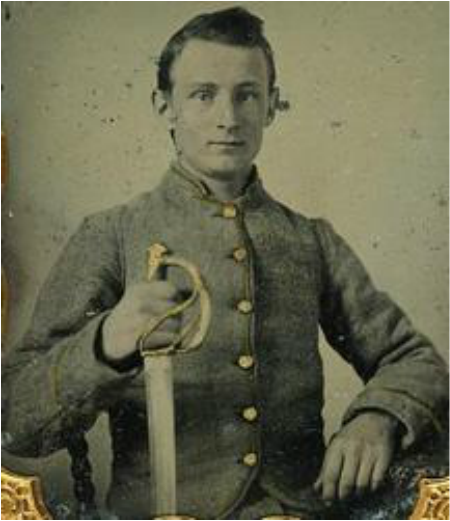
Here is a pre-Civil War Ames saber specimen and forerunner of the type issued to Federal horsemen during the War. Produced by the Chicopee, Massachusetts firm of Ames Sword Company, this weapon is the Model 1860 Light Cavalry saber that was initially called the ‘new pattern’ 1860 saber. This example was one of five thousand such ‘new pattern’ Model 1860 sabers that Ames delivered under its 1859 contract to the Ordnance Dept from 1859 through early 1861. Interestingly, by order of then U.S. Secretary of War John B. Floyd, 1,200 sabers of this 5,000 unit batch of 1859 contract sabers were sent south to Virginia just prior to the war. Considered a more maneuverable, more durable and more finely made weapon than its predecessor, the model 1840 Wrist breaker, the light cavalry saber weighed 3 lbs, 7 oz. in the scabbard. This example has the "US/ G.G.S/ 1859" stamped on the ricasso and the reverse is stamped "Ames Mfg Co / Chicopee Mass". The G.G.S. are the initials of the U.S. inspector G.G. Saunders. Although its correct contemporary description of this saber is the model 1860, many were produced in 1858 and 1859 as was this one.The blade shows considerable dings which could be war damage or may have been used after the war to chop corn. Verbal history on this is that it came out of a barn in Sharpsburg which is near the Antietam battlefield. It was picked up at an estate auction and the best estimate was that it was an early pickup by the farmer living in proximity to the battlefield. Regardless,in the early days of the war both North and South were desperate for weapons and this relic no doubt saw early and prolonged action.
(Reference: "Civil War Cavalry & Artillery Sabers" by John H.Thillmann page 474; Ref: Thillmann Cav. & Arty. Sabers pg. 79; "Historic American Swords" by Howard R. Crouch, page 27; :"The Illustrated History of American Civil War Relics" by Stephen W. Sylvia & J. O'Donnell, page 179; "Swords of the American Civil War" by Richard H. Bezdek , page 149; Arms and Equipment of the Union" by Time-Life Books, page 78;'Warman's Civil War Weapons" by Graham Smith, page 242 )
(Reference: "Civil War Cavalry & Artillery Sabers" by John H.Thillmann page 474; Ref: Thillmann Cav. & Arty. Sabers pg. 79; "Historic American Swords" by Howard R. Crouch, page 27; :"The Illustrated History of American Civil War Relics" by Stephen W. Sylvia & J. O'Donnell, page 179; "Swords of the American Civil War" by Richard H. Bezdek , page 149; Arms and Equipment of the Union" by Time-Life Books, page 78;'Warman's Civil War Weapons" by Graham Smith, page 242 )
ORIGINAL U.S. MODEL 1860 CAVALRY SABER SCABBARD
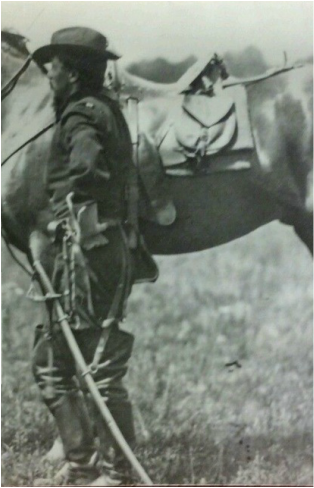
Original Civil War scabbard for the model 1860 saber. This one has the throat intact as well as the two mounts and rings. It is 34 inches in length and is missing the drag and a couple of inches off of the bottom. The scabbard had a surface coat of rust and was coated with what appears to be varnish many years ago. This was purchased in the Shiloh area and obviously someone took the time to preserve it so it may well be a battlefield pick-up but the history of this relic has been lost to time.
(Reference: "Civil War Cavalry & Artillery Sabers" by John H.Thillmann page 474; Ref: Thillmann Cav. & Arty. Sabers pg. 79; "Historic American Swords" by Howard R. Crouch, page 27; :"The Illustrated History of American Civil War Relics" by Stephen W. Sylvia & J. O'Donnell, page 179; "Swords of the American Civil War" by Richard H. Bezdek , page 149; Arms and Equipment of the Union" by Time-Life Books, page 78;'Warman's Civil War Weapons" by Graham Smith, page 242 ).
CONFEDERATE ARMORY SWORD
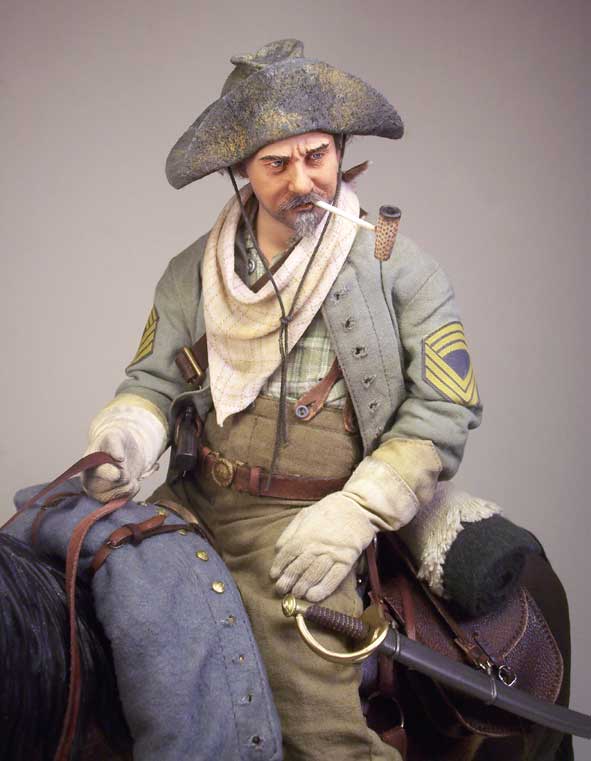
The dealer bought this saber directly from the decedents of Erastus C. Anderson who was a Confederate private and served in C Co. TN 9th Battalion Cavalry. According to the dealer this sword is a product of The Confederate States Armory You can tell from the pictures this has all the traits that you look for in Confederate manufactured swords including redish brass, scabbard with lapsed seam, blade with unstopped fuller, and typical faults in the manufacturing process.The scabbard has lots of dings consistent with heavy use and the brass has great patina. I SOLD THIS ITEM AT AUCTION JUNE 26, 2010
(Reference; "Confederate Edged Weapons" by William A. Albaugh III; "Historical American Swords" by Howard R. Crouch ; "Swords of the American Civil War" by Richard H. Bezdeck; " Confederate Arms" by William A. Albaugh lll and Edward N. Simmons; "A Photographic Supplement of Confederate Swords" by William A. Albaugh III)
(Reference; "Confederate Edged Weapons" by William A. Albaugh III; "Historical American Swords" by Howard R. Crouch ; "Swords of the American Civil War" by Richard H. Bezdeck; " Confederate Arms" by William A. Albaugh lll and Edward N. Simmons; "A Photographic Supplement of Confederate Swords" by William A. Albaugh III)
